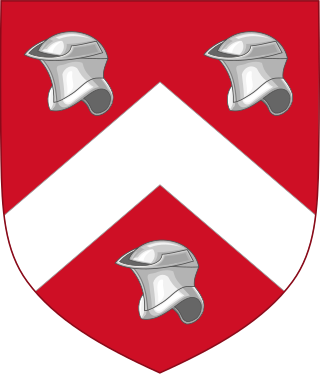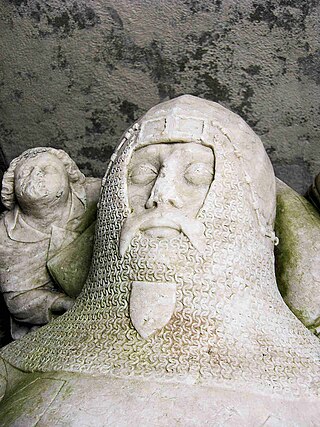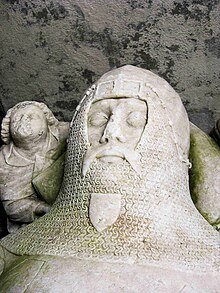
Sir Owen Tudor was a Welsh courtier and the second husband of Queen Catherine of Valois (1401–1437), widow of King Henry V of England. He was the grandfather of Henry VII, founder of the Tudor dynasty.

The Kingdom of Gwynedd was a Welsh kingdom and a Roman Empire successor state that emerged in sub-Roman Britain in the 5th century during the Anglo-Saxon settlement of Britain.

Madog ap Llywelyn was the leader of the Welsh revolt of 1294–95 against English rule in Wales. The revolt was surpassed in longevity only by the revolt of Owain Glyndŵr in the 15th century. Madog belonged to a junior branch of the House of Aberffraw and was a distant relation of Llywelyn ap Gruffudd, the last recognised native Prince of Wales. During his revolt, Madog issued a land grant in which he used the title "Prince of Wales".
Ednyfed Fychan, full name Ednyfed Fychan ap Cynwrig, was a Welsh warrior who became Seneschal to the Kingdom of Gwynedd in Northern Wales, serving Llywelyn the Great and his son Dafydd ap Llywelyn. Ednyfed claimed descent from Marchudd ap Cynan, Lord of Rhos, 'protector' of Rhodri Mawr, King of Gwynedd. He was the patrilineal ancestor of Owen Tudor and thereby of the Tudor dynasty.

Powys Fadog was the northern portion of the former princely realm of Powys.
Gruffudd Fychan II was Lord of Glyndyfrdwy and Lord of Cynllaith Owain c.1330–1369. As such, he had a claim to be hereditary Prince of Powys Fadog, and was a member of the Royal House of Mathrafal. His son, Owain Glyndwr, started the Welsh Revolt and became Prince of Wales.
Trecastell is a farm and historical site in the community of Aberffraw, Anglesey, Wales.
Gruffudd or Gruffydd is a Welsh name, originating in Old Welsh as a given name and today used as both a given and a surname. It is the origin of the Anglicised name Griffith[s], and was historically sometimes treated as interchangeable with the etymologically unrelated Germanic name Galfrid. The Welsh form evolved from the Common Brittonic Grippiud or Gripuid. The meaning of the name is “strong lord.”

The Royal House of Mathrafal began as a cadet branch of the Welsh Royal House of Dinefwr, taking their name from Mathrafal Castle. They effectively replaced the House of Gwertherion, who had been ruling the Kingdom of Powys since late Roman Britain, through the politically advantageous marriage of an ancestor, Merfyn the Oppressor. King Bleddyn ap Cynfyn would join the resistance of the Anglo-Saxon King Harold Godwinson, against the invasion of William the Conqueror, following the Norman conquest of England. Thereafter, they would struggle with the Plantagenets and the remaining Welsh Royal houses for the control of Wales. Although their fortunes rose and fell over the generations, they are primarily remembered as Kings of Powys and last native Prince of Wales.
Rhys ap Tudur was a Welsh nobleman and a member of the Tudor family of Penmynydd. He held positions of power on behalf of King Richard II of England, including two periods as the Sheriff of Anglesey in the 1370s and 80s. Rhys accompanied the king on a military expedition to Ireland in 1398, but in 1400 began to support the revolt of his cousin Owain Glyndŵr against King Henry IV of England. In 1401, he and his brother Gwilym ap Tudur took Conwy Castle after infiltrating it, and liaised with Henry Percy prior to his own rebellion in 1403. After being outlawed by the king in 1406, Rhys was captured and executed at Chester in 1412, although later oral tradition claims he returned to Anglesey to die there.
Maredudd ap Tudur was a Welsh soldier and nobleman from the Tudor family of Penmynydd. He was the youngest of six sons of Tudur ap Goronwy and was the father of Owen Tudor. Maredudd supported his cousin the Welsh patriot Owain Glyndŵr in 1400, alongside his brothers Rhys ap Tudur and Gwilym ap Tudur.

The Tudors of Penmynydd were a noble and aristocratic family, connected with the village of Penmynydd in Anglesey, North Wales, who were very influential in Welsh politics. From this family arose Sir Owen Tudor and thereby the Tudor dynasty, that ruled the Kingdom of England from 1485 to 1603. The Tudor dynasty ended in the early 17th century with the death of Elizabeth I.

Tudur ap Goronwy was a Welsh landowner, soldier and administrator of the Tudors of Penmynydd family from the island of Anglesey.
Tudur Hen or Tudur ap Goronwy was a Welsh aristocrat and original founder of the House of Tudor. He was one of three sons of Goronwy ab Ednyfed who received lands from King Edward I of England. Nonetheless, he backed the rebellion of Madog ap Llywelyn, but afterwards swore allegiance to both Edward I and his son, Edward of Caernarfon. Tudur Hen was responsible for the restoration of the Franciscan friary at Bangor, where his body was later placed on 11 October 1311.
Goronwy ab Ednyfed was seneschal to Llywelyn ap Gruffudd, king of Gwynedd. Goronwy was the founder of the Tudor family of Penmynydd.
Gwilym ap Tudur was a Welsh nobleman and a member of the Tudor family of Penmynydd. In 1401, he and his brother Rhys ap Tudur took Conwy Castle after infiltrating it, in support of their cousin Owain Glyndŵr. Gwilym was subsequently pardoned in 1413, following the execution of his brother a year earlier.
Gwilym ap Griffith, also known as Gwilym ap Gruffydd, was a Welsh landowner. He briefly lent his support to Owain Glyndŵr in the Glyndŵr Rising. When his loyalty returned to the Crown, he was granted the lands of number of Glyndŵr supporters and by the end of his life had ownership of the majority of the lands previously held by the Tudors of Penmynydd.
The Oxford Book of Welsh Verse (1962), edited by Thomas Parry, is an anthology of Welsh-language poetry stretching from Aneirin in the 6th century to Bobi Jones in the 20th. No translations of the poems are provided, but the introduction and notes are in English. It was the first anthology to give the reader a thorough idea of Welsh poetry in its entirety through 1400 years, containing as it does 370 poems, of which 59 cannot be securely attributed while the rest are the work of 146 named poets. It went through eight editions in its first 21 years, and was supplemented in 1977 by the publication of Gwyn Jones's Oxford Book of Welsh Verse in English.






